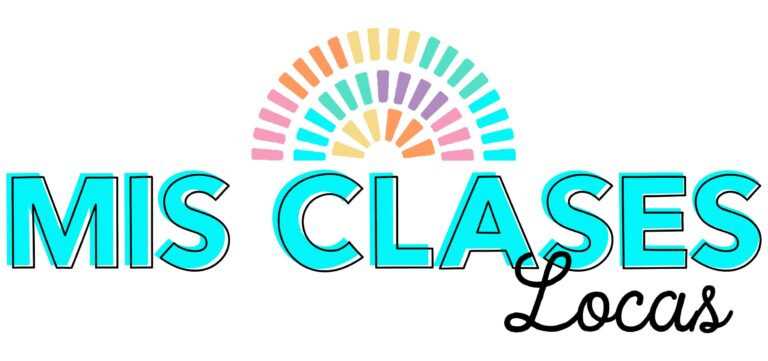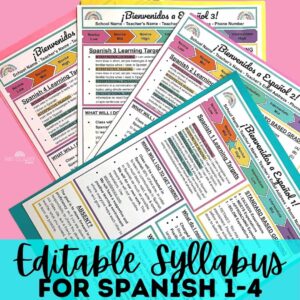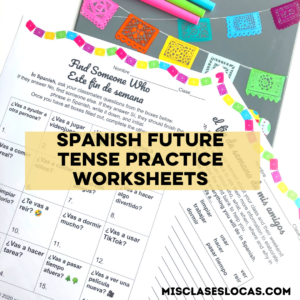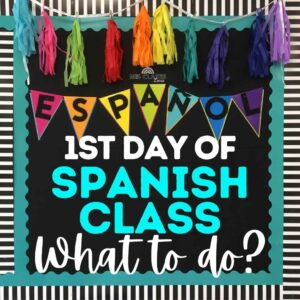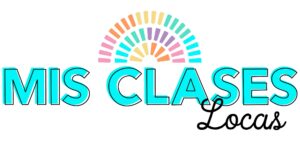By Allison Wienhold. Original Idea posted 7.13.16 & most recently updated 7.2.24.
Inside: 1st week of Spanish Class using CI. The first week of Spanish class plans using comprehensible input.
When I originally wrote this blog post about plans for the 1st week of school using CI, I was 9 months pregnant. I had all these great ideas for starting the year in Spanish class using comprehensible input. But, I knew I would be on maternity leave the 1st day of Spanish class.
So I shared here the rough plans that later became my very popular High-Frequency Verb Unit to Start Spanish 1. **Update you can now download all of these plans as a Spanish Super 7 high frequency verb unit. Or the same unit, but in French.

Original Blog Post – 1st week of Spanish Class using CI
Some of my most popular posts of all time revolve around what to do during the first week of Spanish class (1st Week of Spanish Class – Daily Plans , Unit 1 & 1st Day of Spanish Class). As you may know this year I will not be at school the first day, since it is my due date for baby boy #2! Since it is a topic that so many of you are interested in, I will share what I would be doing if I were there the first week of this year, with more of a comprehensible input focus.
If you are starting at a new school or will have all students who are new to you, I would recommend following this week-long Unit 1 that focuses on proficiency, procedures, and positive people. One of the main activities is the Proficiency Puzzle. It helps students new to the concept of language proficiency learn to distinguish proficiency levels. It also helps them figure out what will be expected of them during the year (per your Syllabus). You can see my Daily Plans post for exactly what I did each day last year. You can download everything you need in this Back to School Bundle.

1st Week of Spanish Class – This year
This year I am in the unique #deptof1 situation that I already know and have had every student. The only exception would be any new students to the district.
I even know Spanish 1, since I had every 7th and 8th grader last year in Exploratory Spanish. This means in Spanish 1 we can skip a lot of the typical first-week introductions. We can get right into the focus, the Super 7 verbs (from Terry Waltz – es, tiene, le gusta, hay, está, va, quiere). Below is the tentative plan for Spanish 1.
Update for upper levels >> 1st Day of Spanish 2, 3, 4 Plans
1st Day of Spanish 1 Plans
** See High-Frequency Verb Unit to Start Spanish 1 for the most up to date plans **
Day 1 – Spanish 1 (from Spanish Super 7 unit or French Super 7 Unit)
BEFORE CLASS – Spanish Music will be playing, all desks will have these seating cards & students can take pictures with the Instagram Photo Booth
GREET – Greet all students at the door in Spanish with a smile, handshake, and a seating card. I will ask their name in Spanish, modeling “Me llamo ____” “¿Cómo te llamas?”
INTRO MYSELF – Make sure that all students know who I am, flipping through a few pictures of my summer in a slideshow to talk about what I did prompting discussion.
NAME GAME SPEEDBALL– This is a fun way to review how to introduce yourself and is essential to class bonding if there are any new students. You can grab a Name Game Freebie to use Day 1 below.
Pass out Syllabus & Parent Newsletter for Spanish class At the end of the class.
**If this is a new class with new faces, I would stop here. We would play multiple rounds of the name game, learning everyone’s names.
PERSONA ESPECIAL – Since I know everyone’s names, we will not be making nameplates and instead will go right into special person interviews from Bryce Hedstrom. I will ask for an outgoing volunteer to sit on the special stool, and as a class, we will ask them questions. Depending on time, we may go through a couple of people and then do a quick free write at the end to write down everything they remember about their classmates for future use. Each day of the week there will be one target structure of the super 7 that will be introduced and focused on.
Day 1 – Focus Word of Super 7 – es
- ¿De dónde eres? – Soy de… Es de…
- ¿Eres (cognate adjectives – ex. atletico) – Soy… Es…

Day 2
PERSONA ESPECIAL – We will go through a few more students to get to know our class and practice basic phrases. We will review the focus word from the previous day and add a new focus word.
Day 2 – Focus Word of Super 7 – tiene
If you just did name Game Speedball Day 1, do Day 1 above instead)
- ¿Cuántos años tienes? – Tengo ___ años. Tiene ___ años.
- ¿Tienes hermanos/animales? – Tengo… Tiene
NAME GAME SPEEDBALL– as a brain break
START STATIONS – For all of those necessary first week logistics, I like to do quick stations that students move through at their own pace. These involve completing the following tasks:
- Instagram Photo Booth – Take and post pictures in the using out class hashtag.
- Parent Newsletter/video permission form – Students pick up & take home to get signed.
- Google Classroom – Students sign up using the class code.
- Info Form – Once on Schoology, they fill out the posted Google Form that helps me get to know them, their interests, and their language abilities
- Syllabus – Students look through the posted syllabus and post questions or comments on Schoology.
- Proficiency Puzzle– Students work with a partner to distinguish proficiency levels. We will discuss these later once everyone is done.
Day 3
MÚSICA MIÉRCOLES (or whenever Wednesday falls)
PERSONA ESPECIAL – We will go through a few more students to get to know our class and practice basic phrases. We will review focus words from previous days and add a new focus word.
Day 3 – Focus Word of Super 7 – le gusta
- ¿Qué te gusta hacer? – Me gusta ___. Le gusta___
- FINISH STATIONS
Day 4
PERSONA ESPECIAL – We will go through a few more students to get to know our class better. We will review focus words from previous days and add a new focus word. Students will complete a free write on all those we have learned about so far.
Day 4 – Focus Word of Super 7 – hay
- ¿Cuántas personas hay en tu familia? – En mi familia hay ___personas. Hay ___ personas en la familia de ___.
GO OVER STATIONS
- Syllabus – Discuss questions or clarifications.
- Proficiency Puzzle– Go over proficiency levels, class expectations and have students make their own proficiency goal. Students write this goal down and share with the teacher.
Day 5
PERSONA ESPECIAL – We will go through a few more students to get to know our class better. We will review focus words from previous days. Students will complete a free write on all those we have learned about so far.
STORY – The class will create a story using the four target structures of the super 7 so far (es, tiene, le gusta, hay) and using two volunteer actors. The goal is our story will use some of the real information we learned about the class during the special person interviews. Below is just a basic example that uses the target structures. You can find the story in this unit.
STORY EXTENSION – Depending on how much time we have, we may do some type of story extension, while I type up the class story. This may be that students make a storyboard or mural to retell the story the next week.
The next week would continue with adding in the rest of the super 7 – está, va, quiere.
** See High-Frequency Verb Unit to Start Spanish 1 for the most up to date plans for a full 2 weeks.

Resources & posts for back to school
- all posted labeled back to school
- 1st Week of Spanish Class – Daily Plans 2015
- 1st Week of Spanish Class – Unit 1 2015
- 1st Day of Spanish Class 2014
- Parent Newsletter
- Syllabus
- Proficiency Puzzle
- Back to School Bundle
- Instagram Photo Booth
- Name Game Speedball
- 1st Day of Spanish 2 & Spanish 3

